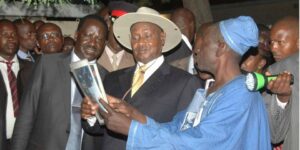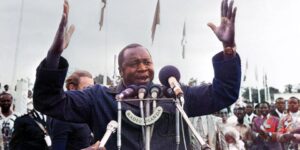At 77, Raila Odinga has perhaps exhausted his chances of becoming Kenya’s President — unless he decides to run again in 2027 and at 82 — the same age at which his father, Jaramogi Oginga Odinga, made his first bid for the presidency.
But this is not about the recent Kenyan elections. It is about a little-talked-about contribution by the Odinga family in the removal of Idi Amin in Uganda — and how Chris Mboijana, a business ally of powerful Kenyatta-era provincial administrator Eliud Mahihu got entangled in the Uganda wars.
The Odingas, when they are finally studied, will be one of the most complex families in our history.
They have straddled the Kenyan political scene from colonial times through two generations without a break.
And during that period, they were ostracised, praised, ridiculed, detained, and cajoled.
Equally, the Odingas have been involved in the fight for democracy, human rights, and expansion of other freedoms more than any other family in Kenya.
For that, the Odingas are loved and hated in equal measure — with no space for neutrality.
They have been labelled anarchists, violent, democrats, communists, and freedom fighters. In between, they have brokered deals, both overt and covert, made money like other politicos, and built a successful portfolio in the energy sector.

At one point in the 1970s, they were almost bankrupt.
With no heir emerging from the family, Raila Odinga might be the last powerful titan of the House of Jaramogi.
While the family has been well known in Kenya since the 1950s, how it contributed to the push to overthrow Idi Amin has not gained currency.
But it is a story that helps us study the Odingas in the East African region, outside Kenyan politics.
How Jaramogi opened his Opoda Farm in Siaya to guerrillas opposed to Idi Amin shows the internationalisation of efforts to remove the Ugandan dictator.
It is also a study on how regional politicians took it upon themselves to help exiled Ugandan politicos.
Amin surprised many after he took over power in Uganda in 1971 with the support of Britain, which detested Milton Obote’s criticism of South Africa’s apartheid regime.
Others who actively supported the coup were Israel and some sections of the Kenyan intelligence.
The British government later gave Amin £10 million and 51 armoured cars.
More so, “despite all the press hysteria about Amin and his massacre of about 300,000 people, hardly any newspaper discovered the British government’s role.
The Stanstead shuttle of whisky and luxuries to the military continued until Amin was at last overthrown in February 1979,” writes Will Podmore in his book British Foreign Policy since 1870.
Jaramogi had a reason to stop Amin, who was, at first, a British project in the region before they fell out.
But, as the Guardian recently revealed from declassified documents, there existed a special Foreign Office propaganda unit, Information Research Department IRD), which ran a three-year campaign against Jaramogi to undermine his rise.
The problem with Odinga was that he favoured radical land policies in Kenya, which undermined British interests.
The IRD, through its dirty tricks section — Special Editorial Unit — ran four ‘black’ propaganda operations against Jaramogi that involved the publishing of damning material.
Some of those propaganda pamphlets were titled ‘People’s Front of East Africa’ and attacked Kenyatta as “reactionary, fascist and dishonest.”
On the other hand, it praised Jaramogi as a “great revolutionary leader”. Although Odinga complained about this hate campaign, he never came to know of the existence of a British propaganda unit that specifically targeted him.
Thus, he had a reason to support any course against British interest in the region.
Facilitated movement
In his autobiography, The Flame of Freedom, Raila Odinga reveals how Jaramogi facilitated the movement of the likes of Yoweri Museveni and Brigadier Oyite Ojok, a Uganda National Liberation Front (UNLF) leader, into Uganda.
He writes: “Jaramogi’s cooperation was sought to facilitate their movement across the border to the eastern part of Uganda, and a channel was organised through which armed men moved clandestinely into Uganda from Tanzania.”
Ojok, a Lang’o, was a lieutenant colonel in the Obote government but was forced to flee to exile after Idi Amin took power.

In Kampala, there were always rumours that Ojok had been sighted.
Meanwhile, Jaramogi’s Opoda Farm would host “several hundred” guerrillas as they prepared to go and attack Tororo barracks.
After Amin’s fall, Raila made a trip to Uganda to see the devastation. “We had a glimpse of the difficulties that would be faced in rebuilding Uganda,” he writes.
Later, soldiers would give Raila, and his cousin, Okach Ondiek, a four-wheel drive vehicle previously used by Amin’s State Research Bureau, and they drove north to Lira.
“Wherever we went, people ran to hide as soon as they caught sight of us. During Amin’s time, the presence of the Bureau vehicle had spelt doom. People were either shot on sight by Bureau assassins or driven away and never seen again,” reveals Raila in his book.
How various interests would converge at Opoda Farm as the construction site of Uganda’s rebellion has never been appreciated.
Mboijana role
Besides Jaramogi’s Opoda Farm, another Uganda investor, Chris Mboijana, helped build Museveni’s army from his Kabete house.
Mboijana was Uganda’s equivalent of Kenya’s Charles Njonjo. Both dressed immaculately, were cunning and calculating, and had been admitted to the Bar in London.
They had returned to East Africa almost at the same time. While Njonjo had joined the State Law office in Nairobi, where he easily became the Attorney General at Independence, Mboijana became one of the most prominent Kampala lawyers during the reign of Obote.
Trained in India, the lawyer had set up a successful business in Nairobi after escaping the Idi Amin atrocities. As he fled Uganda, newspapers reported that the lawyer had been killed.
With the fall of Idi Amin in 1979 and the installation of the short-lived government of Yusuf Lule, Obote’s former Attorney-General, Godfrey Binaisa, took power. Binaisa’s minister for Defence was Museveni.
After he clashed with some military figures on how to build an army, the President, in his bid to entrench himself fired Museveni on November 18, 1979.
Museveni then retreated to South Western Ankole, where he started to wage war against Binaisa.
The reason Museveni found support from the Uganda millionaire Chris Mboijana can be deduced from the following business war.
It happens that in 1962 when Milton Obote appointed Binaisa as his Attorney-General, the lawyer handed over his firm of Binaisa, Lubowa, and Ibingira to Mboijana — in the understanding that he would rejoin it once he ceased to be Uganda’s Attorney-General.
By mutual consent, the name of the firm had been changed to Binaisa, Mboijana, and Co, but had in 1966 been changed to Mboijana and Co. When Binaisa tried to get it back, Mboijana blocked him, and they badly fell out.
With Binaisa as President, Mboijana knew that his goose was cooked.
Business interests
In 1967, Mboijana had fled Uganda and registered the Watamu Bay Development Company, which was building Watamu Beach Hotel in Association with Globe Air – a Swiss firm running tourist packages in East Africa.
After he escaped to Kenya, Mboijana became the managing director of Mahihu’s African Safari Airways, which was a joint partnership with Karl Jacob Ruedin, the man who previously managed a Swiss Charter Company for billionaire Peter G. Staechelin.
Staechelin had a story too. He was the son of a billionaire art collector who had taken advantage of the First World War to buy Van Gogh art collections and others by Picasso, which he sold to support his airline.
The airline was later brought down by a compensation case after one of the aircraft had an accident in Nicosia, Cyprus, which was blamed on Ruedin, before he flew to Kenya to partner with Mahihu.
Ruedin had the capital, Mahihu had the power, and Mboijana had the management experience. The three met and established a chain of hotels and an airline.
That is how Mahihu got entangled in Ugandan politics, and Kenya would later be dragged into efforts to reconcile the various groups.
The quest to remove Binaisa had a business angle to it. Fast forward, Mboijana mysteriously died in London in 1990 when he was the general manager of Uganda Airlines. Some say he was murdered.
It is not clear whether the Odinga family had any stake in Uganda besides aiding the rebels to topple Amin, or if they were just being nice.
Credit: Source link